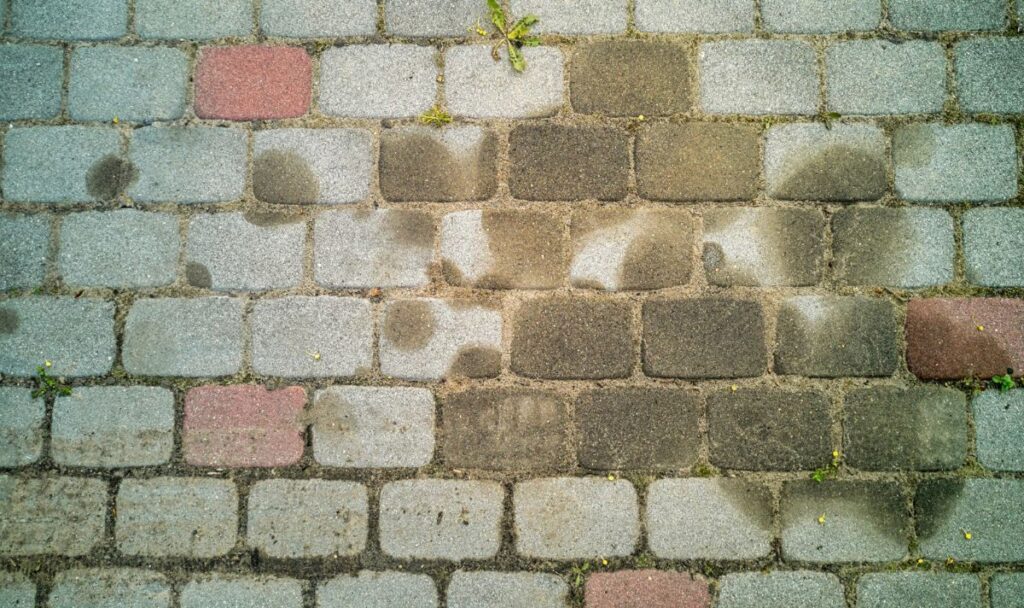A popular choice for driveways, pathways and patios across the UK, block paving is a versatile and structurally strong surface, making it perfect for driveways. However, as with all surfaces of this kind, block paving can easily fall victim to stubborn marks and stains that can ruin the pleasing aesthetic of driveways. Paving experts at Armstrong Supplies have shared the “most effective methods” of removing oil stains and marks from block paving, helping to keep driveways in tip-top condition.
They said: “Unsurprisingly, oil stains are the most common blemish found on block paving.
“Following spillages and leaks, motor oil absorbs into the porous surfaces of bricks and paving slabs leaving marks that can be difficult to remove.”
Of course prevention is the best cure when it comes to oil stains. If households notice that their car has been leaking oil, it is a good idea to put down a drip tray or piece of cardboard to prevent stains from growing or even occurring in the first place.
When it comes to getting rid of oil stains the first step is to cover the marks with sawdust before attempting to clean the area.
READ MORE: Remove ‘stubborn’ moss from paving in ‘15 minutes’ with one ingredient
The paving pros said: “Brush this substance into the stain and leave covered for at least 20 minutes. This will help soak up any excess spilt oil on your surface and make the cleaning process easier.
“Interestingly, cat litter is also very effective for this job. Once any excess oil has been absorbed, sweep the sawdust away using a dustpan and brush.”
Next, the area will need to be cleaned with a regular hose or bucket of cold water. This will wash away any dirt or debris that is in the way and will better allow for cleaning agents to get to the oil.
However, the experts urged: “It is important to note, do not use a high-pressure power hose or jet washer. This could result in the greasy oil being pushed deeper into your block paving, making it even harder to remove.”
Ensuring protective eyewear and gloves are being worn, pour detergent onto the affected area. For small oil stains, the pros suggested: “You can try to remove the grease using a bottle of standard cola first.
“Let the fizzy drink sit on the oil stain for 24 hours before washing the affected area with a hose or bucket of water, washing away any remaining cola and oil residue.” If the stain still remains, a stronger chemical will be required.
For the majority of oil stains, the expert claimed: “A simple household product such as washing-up liquid, baking soda, white vinegar, or laundry detergent is enough to lift tricky oil stains.
“Once your chosen detergent has been liberally applied to the stained block paving, allow it to sit for 30 minutes.”
READ MORE: ‘Right time’ of day to mow lawn – ‘significantly’ helps grass ‘thrive’
Rinse the affected area with warm water and scrub using a steel wire brush. It is important to brush vigorously, creating a lather that covers the marked bricks or slabs.
Next, wash away the detergent and any oil residue using a hose or full bucket of water. Allow the area to dry and then inspect.
If the oil stain remains visible, the paving gurus instructed: “Sprinkle powdered laundry detergent onto the stain and add a quarter cup of hot water to create a thick paste to cover the stain.
“Finally, scrub the affected area of block paving with the steel wire brush and leave it overnight. If the stain is still visible after you’ve re-scrubbed and washed the following day, you should repeat the entire process.”
In extreme cases in which stubborn stains cannot be removed using this wash and repeat process, a degreasing agent or engine cleaning fluid can be used.
However, it’s important to test a small, less visible area of paving with these chemicals for any adverse or unexpected reactions before treating larger areas.
Finally, if an oil stain is really not shifting, it could be worth considering replacing the affected area.
Thanks to the typically easy installation methods associated with block paving, this can often involve a very simple and inexpensive process.

